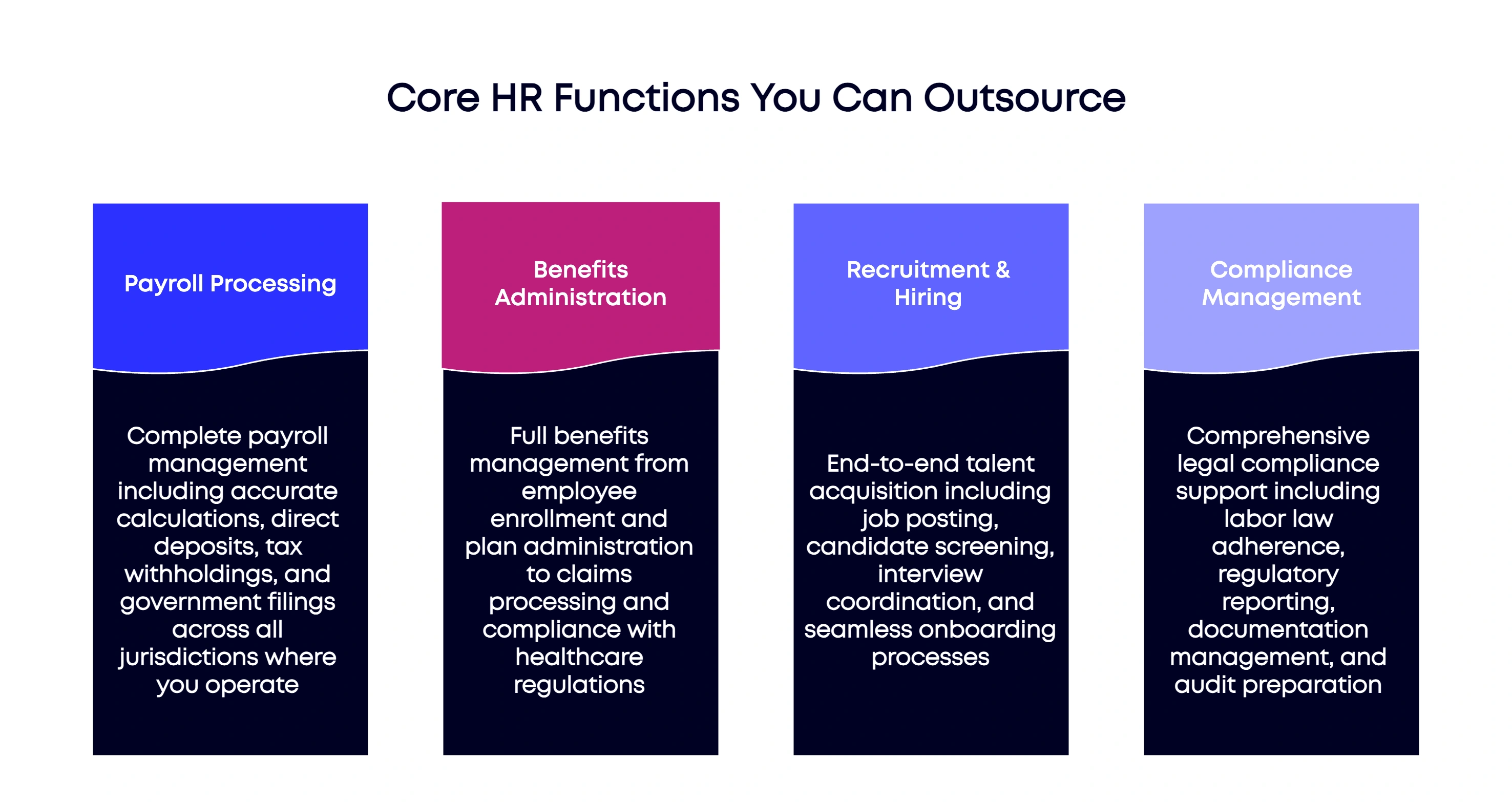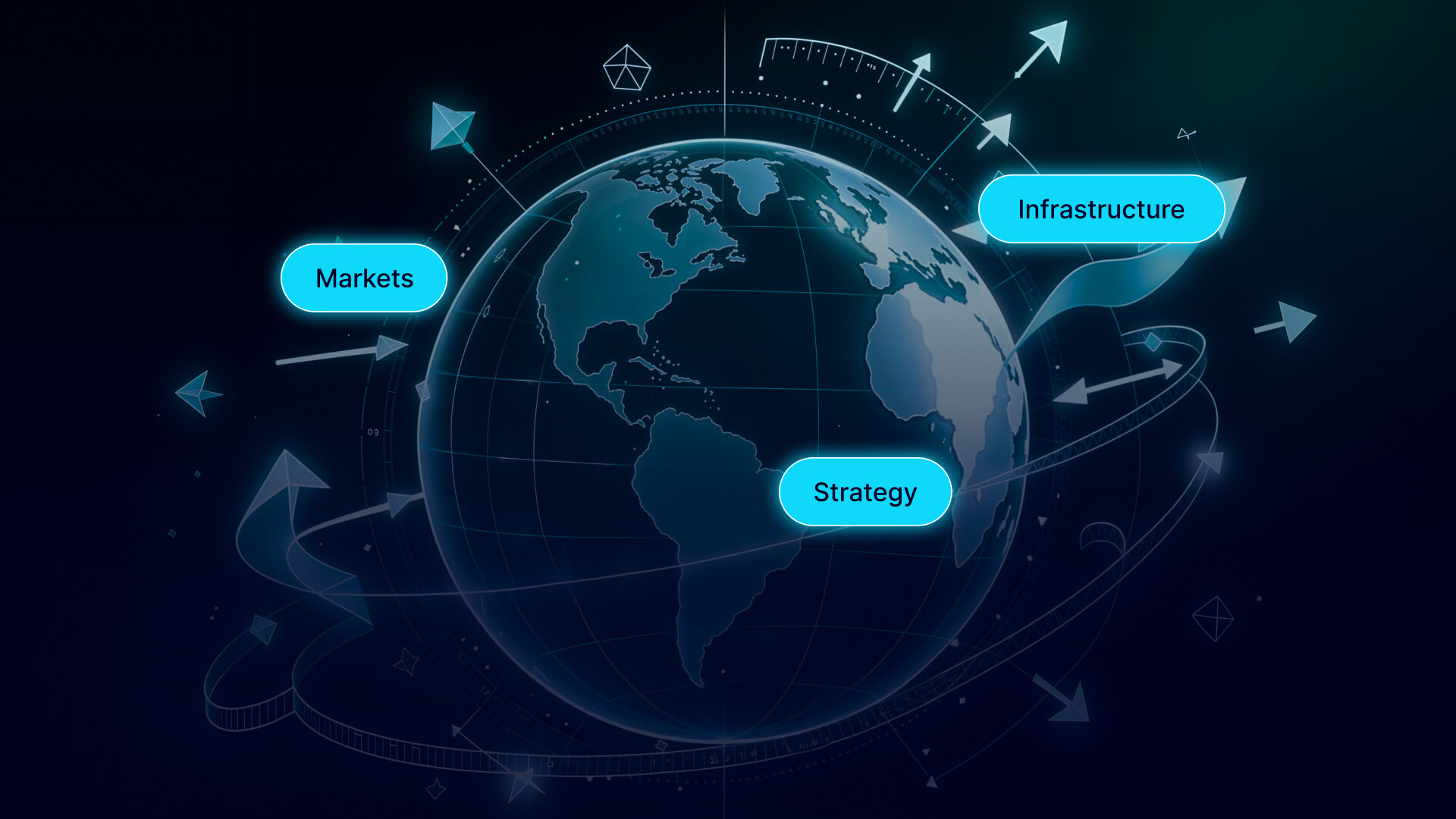Pros and Cons of Outsourcing HR: Key Takeaways
In 2024, the HR outsourcing market soared to an eye-popping $261.7 billion. But even with all that growth, many companies still get the basics of HR outsourcing wrong.
We’ve seen both extremes.
On one side, companies pull in up to 191% ROI because they understand what outsourcing HR really entails. On the other, some lose top performers by chasing budget cuts without a clear plan. The difference isn’t luck. It’s clarity.
Right now, more than 57% of companies outsource at least one HR function. And that’s not a trend - it’s the norm.
Which means the big decision isn’t whether to outsource, but how well you understand the trade-offs.
Here’s what the numbers show:
- $3,000 saved monthly on payroll alone, on average.
- 62% of companies that skip HR support when expanding face penalties in year one.
Done right, HR outsourcing supports global growth. Done wrong, it stalls it.
This guide breaks down the real pros and cons to help you see the full picture before you decide.
What is HR Outsourcing?
At its core, HR outsourcing means bringing in a third-party partner to take over some - or even all - of your HR responsibilities. Instead of juggling everything internally, companies bring in outside experts who do this every day.

There are three main ways companies typically structure this:
- Traditional HRO Services: You outsource specific pieces (like payroll or benefits), but your employees still work directly for you. This is the most common setup - payroll alone is included in 70% of HR outsourcing deals.
- PEO: This is a shared model where you and the PEO (Professional Employer Organization) split employer duties. You still run the day-to-day, but the PEO handles things like taxes, benefits, and compliance as a co-employer.
- EOR: Ideal for global teams, the EOR (Employer of Record) becomes the legal employer in each country where you operate. That means you can hire internationally without setting up a local entity - huge for fast-moving companies expanding abroad.
In fact, the EOR space grew 28% in 2023 alone, thanks to the remote work boom.
Much of this growth comes from companies hiring in India, where the talent pool is massive and the cost advantages are substantial.
But it’s not just one-size-fits-all - many businesses take a blended approach. They might keep their core HR strategy in-house, while outsourcing the paperwork-heavy work to free up time and reduce risk.
Modern outsourcing also comes with serious tech perks.
Around 68% of today’s contracts include cloud-based platforms and AI-driven tools for things like performance tracking and analytics - giving companies access to systems they’d otherwise spend months (and a lot of money) building themselves.
The 7 Pros of Outsourcing HR Every Global Company Should Know
Outsourcing HR isn’t just about delegation - it’s a strategic move with measurable returns. The right partner can streamline your operations, improve compliance, and make global growth feel a lot less overwhelming.
Let’s break down the biggest benefits companies are seeing in the real world.
Knowing your HR costs upfront
Managing HR in-house often comes with more surprise expenses than companies expect.
A single HR manager might have a $126,000 salary, but add in benefits, software tools, training, and overhead, and you’re suddenly pushing $180,000 annually for a basic internal team.
With outsourcing, those fluctuating costs become a flat, predictable monthly fee.
Most providers charge between $50–$200 per employee per month, or 3–12% of gross payroll - and that includes everything from payroll to compliance support.
Interesting Fact: Companies that outsource HR report an average ROI of 191% - not just from direct cost savings, but also from avoiding penalties and inefficiencies that catch internal teams off guard. And working with the best recruiting company amplifies these returns by ensuring you hire the right people faster.
But the transparency matters more than the savings.
Instead of scrambling to cover an unexpected legal consultation or emergency software upgrade, you get one monthly invoice that covers it all. We had a client cut out $2,524 per employee in random HR expenses just by outsourcing.
Access to cross-border expertise without new entities
Hiring in a new country sounds exciting - until you realize it could take a year and tens of thousands of dollars just to set up a legal entity.
Every country has its own web of tax laws, employment rules, and cultural nuances.
That’s where HR outsourcing earns its keep. With an Employer of Record (EOR), you can legally hire talent in a new country in a matter of weeks - no local entity required.
.webp)
Did You Know? Over 60 new employment laws have rolled out globally since 2021. EOR providers have local legal teams that stay on top of changes so you don’t have to.
Many companies learn the hard way:
62% of firms that expand internationally without HR support end up paying compliance penalties in the first year. Outsourcing helps you avoid becoming part of that statistic.
HR coverage whenever - and wherever - your team works
Today’s workforce isn’t tied to a single office - or a single time zone. With 71% of teams hiring globally, HR issues can arise at any hour.
An in-house HR team working 9–5 simply can’t keep up.
Outsourced HR providers offer 24/7 support, often through regional service centers. That means your team in Europe or Asia doesn’t have to wait until your U.S. office wakes up to get help.
When more serious issues arise - like a harassment claim or a payroll glitch - round-the-clock access to real human support prevents minor problems from snowballing into major ones.
Filuet Tip: Many companies are exploring outsourcing to India as a strategic way to access skilled professionals while maintaining round-the-clock support.
Scalable workforce operations that flex with demand
Business rarely moves in a straight line. Whether you're growing, shrinking, or running multiple projects, your provider adjusts to meet the demand.
- Add 50 employees? Your fee adjusts.
- Need to pause hiring next quarter? You don’t carry the overhead.
- Launching a new product line with 100 temporary hires? No problem.
You don’t need to hire or lay off HR staff with every fluctuation.
We’ve worked with clients who grew from 15 to 100 employees in under a year, then scaled back just as smoothly when things stabilized. That flexibility is almost impossible to replicate with an in-house team.
Digital HR tools you don’t have to build
Modern HR runs on tech - but building that tech in-house is a major undertaking.
Subscriptions alone can cost tens of thousands each year, and that’s before you factor in setup, customization, and ongoing updates.
- Small businesses often pay $6–$12 per employee per month for basic HR tools.
- Larger companies spent $15–$25 per employee per month for full-featured systems.
Outsourcing HR includes that state-of-the-art tech as part of the service.
Professional global HR solutions include that state-of-the-art tech as part of the service.
Leading providers incorporate AI and automation extensively. Around 68% of HR outsourcing contracts now come with advanced software, often featuring:
- Automated payroll audits (reducing errors by up to 19%)
- AI-powered analytics
- Mobile employee portals
- Built-in tools for compliance and performance tracking
Pro Tip: You don’t just get access - you get it immediately. While implementing a new HRIS in-house can drag on for months, outsourced providers already have fully functional platforms ready to go.
These systems are also constantly updated. When a provider upgrades its analytics tools or launches a chatbot to answer common HR questions, you get those features automatically.
So instead of juggling multiple vendors or licenses, you get a single, seamless HR tech stack that just works - and keeps working.
Shared Responsibility on Regulations
Navigating compliance today means more than checking boxes. Between federal, state, and local laws - not to mention international regulations - it’s a moving target with serious consequences.
Outsourcing HR shifts that risk away from your internal team.
Providers have legal and compliance experts who track changing rules and update practices in real time. Companies using outsourced compliance platforms experience 24% fewer audit issues.
The liability coverage differs:
- In a PEO arrangement, responsibilities are shared. If something goes wrong - like a payroll tax misstep - the PEO usually absorbs the penalty. However, when considering PEO vs EOR in india, you'll find that shared responsibility models simply aren't legally possible under Indian employment law.
- With an EOR, liability shifts even more. The EOR becomes the legal employer in each country and takes on nearly all compliance obligations. This key difference in the EOR vs contractor relationship changes your risk level and paperwork burden significantly.
With the right partner, you get compliance protection backed by insurance, plus indemnification clauses that keep your business shielded from costly errors.
Sharper focus on core growth goals
CEOs and founders didn’t launch their companies to manage PTO policies or navigate international tax forms. Yet on average, they spend nearly half their time on HR-related tasks.
When administrative HR is offloaded, executives reclaim a lot of time - up to 20 hours per week. That’s the equivalent of half a full-time leadership hire added back to your strategy team.
The same holds true for managers.
Many waste valuable hours resolving internal disputes or trying to decode compliance documents. With a reliable HR partner in place, those tasks get handled professionally, and teams can get back to their real jobs.
.webp)
When HR stops being a bottleneck and starts being a strategic enabler, everyone - from leadership to the front lines - gets more time to do what they do best.
The 7 Key Cons of Outsourcing HR and How to Offset Them
Every smart strategy comes with trade-offs, and HR outsourcing is no exception.
While the benefits are clear, understanding the potential downsides - and how to address them - can make the difference between success and frustration.
These challenges aren’t deal-breakers. In fact, most are manageable with a bit of foresight and the right partnership structure.
Loss of day-to-day control
One of the top concerns we hear? “We’ll lose control.”
When HR tasks shift to an outside provider, leadership often worries about delays, misalignment, or not having eyes on key decisions.
Suddenly, you can’t just walk over to the HR team for a quick update. Things like payroll timing or policy implementation follow someone else’s schedule.
But this fear is often more perception than reality.
You don’t lose strategic control - just the operational load. You still decide who to hire, how performance is handled, and what policies your team follows. The outsourcing partner handles the how, not the what.
Use Service Level Agreements (SLAs) to define how quickly tasks get done, how issues are escalated, and what success looks like. It’s your lever to stay in control without micromanaging.
.webp)
Many companies go hybrid: keep culture and employee relations internal, outsource the paperwork and compliance. That way, you never lose touch with your people - but you’re not drowning in admin either.
Pro Tip: Your outsourcing contract should clearly state who does what. That includes decision rights, response timelines, and what happens if the relationship doesn’t work out.
Culture mismatch when you hand HR to a partner
Company culture is a delicate topic – it encompasses values, norms, and the “way we do things here.”
HR plays a huge role in shaping that culture - through hiring, feedback, conflict resolution, and how employees experience support.
So it’s no surprise that culture misalignment is a real risk when outsourcing.
If a provider’s tone or style doesn’t match yours, employees notice. What feels like “professional consistency” to them may come off as cold or disconnected to your team.
A mismatch in HR tone - too corporate, too casual, too by-the-book - can quietly erode morale over time.
And when HR feels impersonal, employee trust and engagement can suffer.
How to avoid this:
- Choose partners based on cultural fit, not just cost or features
- Share your values, tone, and communication style during onboarding
- Keep a core internal HR leader focused on culture, values, and team dynamics
You can also involve your HR provider in team calls, all-hands meetings, or onboarding sessions. It helps them understand your company’s values and communication style, so they can interact more naturally with your people.
And don’t wait for problems to surface. Run regular employee feedback surveys on HR support. Catching disconnects early means you can course-correct before they affect engagement.
Hidden fees and SLAs
One big reason companies outsource HR is to gain cost predictability. But sometimes, those savings disappear under a pile of hidden fees and vague service terms.
.webp)
Some contracts even include annual price escalators or minimum billing thresholds, meaning you pay more even if your headcount drops.
How to avoid surprise costs:
- Get a line-by-line breakdown of potential charges before signing
- Ask for real-world examples of what’s considered “extra”
- Negotiate price caps on variable items
- Bundle your most likely needs into fixed monthly pricing
In short, eliminate ambiguity: if something might result in a charge, you want it listed.
And know that contracts aren’t static. Set a semi-annual review to evaluate how often you’re being upcharged. If it keeps happening, it might be time to renegotiate your tier - or your vendor.
Data security concerns when HR goes external
HR data is some of the most sensitive information your company holds - think Social Security numbers, salaries, bank accounts, health data, and performance records.
Transferring that data to an external partner raises real concerns, especially as cyberattacks targeting HR systems are on the rise.
There have been high-profile incidents - like the 2021 ransomware attack on UKG that shut down payroll for weeks, or breaches at background check providers exposing millions of records.
Important to note: even if the vendor is at fault, your company is still legally responsible under most data protection laws (like GDPR).
How to protect yourself:
- Vet vendors for top-tier certifications like ISO 27001 and SOC 2 Type II
- Ask detailed questions about encryption, data access, and breach protocols
- Include strong contract clauses around breach notification and indemnification
- Keep internal backups of critical employee data, just in case
Knowledge transfer gaps
Your internal HR team knows more than what’s written in the handbook. They remember who’s on leave, which policies got flexible exceptions, and the workaround for that one approval glitch in the old system.
That kind of institutional knowledge doesn’t always transfer when you bring in an external provider.
This can result in employees repeatedly explaining past issues, misalignment with established practices, and disruptions when HR procedures affect other departments.
How to avoid this:
- Document everything - not just policies, but processes, in-progress cases, and team norms
- Set up live handoff sessions between your outgoing team and the provider
- Start with an overlap phase, where internal and external HR operate in tandem
Even after full outsourcing, having an internal “HR liaison” – not necessarily an HR professional, but a managerial role that interfaces with the provider – can ensure continuity. This liaison, often someone in finance or operations, keeps track of any recurring issues and makes sure institutional memory isn’t lost.
Employee concerns about outsourced HR
HR changes directly affect employee work lives through pay, benefits, and support systems.
Outsourcing can prompt anxiety or skepticism among staff if not handled carefully, potentially impacting morale and company perception.
People naturally ask:
- “Will they still care about my concerns?”
- “Is this the beginning of more job cuts?”
- “Who do I even talk to now about benefits or problems?”
These reactions are normal - especially if outsourcing isn’t introduced clearly. Some team members might feel like they’ve lost a trusted resource and are now just another ticket in a queue.
How to avoid it:
- Be upfront about why you're outsourcing, what’s changing, and how it helps them
- Highlight the benefits for employees, like faster response times or better tech access
- Introduce the HR provider team early and personally (face-to-face or video helps)
- Keep some familiar HR touchpoints in-house to guide employees through the shift
Remember: HR is all about trust. If employees don’t feel supported, it won’t matter how technically sound your HR systems are.
Over-reliance on one vendor
Outsourcing simplifies your operations - but it also creates risk.
When you rely on a single vendor for multiple HR functions, your entire workforce strategy relies on one company’s stability.
There are several potential risks to consider:
- Tech outages or data breaches
- The vendor gets acquired and changes its approach
- They lose your account manager and service quality drops
- Your internal team loses so much know-how you can’t pivot quickly
How to stay protected:
- Choose vendors with strong financials and clear backup systems
- Include exit provisions: how they’ll return your data, help with transitions, and what penalties apply for poor performance
- Keep a lean internal HR function or liaison familiar with workflows and tools
A little diversification and contingency planning can make all the difference - so if one part falters, everything doesn’t fall apart.
Should You Outsource Your HR?
Given all the pros and cons discussed, the ultimate question for many companies is:
Is outsourcing HR the right move for us?
The answer isn’t one-size-fits-all; it depends on your company’s specific circumstances, goals, and capabilities.
Here, we’ll outline some key considerations to help you evaluate whether (and when) you should outsource your HR, and to what extent.
- Smaller companies (under 100 employees) often benefit the most. They usually don’t have full HR teams, so outsourcing fills those gaps without adding headcount.
- Mid-sized companies (5–150 employees) tend to be in the sweet spot for full-service PEOs. They need solid HR infrastructure but may not be ready for an internal department.
- Larger enterprises often keep strategic HR in-house - think leadership development or culture-building - but outsource high-volume tasks like payroll or benefits admin.
If you’re expanding globally, for example, using an EOR (Employer of Record) can get you up and running in new markets fast - without having to form local legal entities. But the EOR vs staffing agency decision depends on whether you need temporary support or permanent team members.
Here's what we've learned after helping dozens of companies:
The best HR outsourcing relationships don't feel like outsourcing at all.
They feel like having a world-class HR department that scales with your ambitions and operates wherever your team works.
The global workforce demands HR capabilities most companies can't build internally. The question isn't whether to outsource - it's whether you'll do it strategically or wait until administrative burden forces you to.
Your expansion story doesn't have to include plot twists around missed compliance deadlines or talent lost to bureaucracy. It can be the straightforward success of a company that chose the right partner and built something meaningful across markets.
The choice is yours. But you don't have to make it alone, and we are here to guide you.
.webp)
.webp)


.webp)











